- About
- Mission Statement
Education. Evidence. Regrowth.
- Education.
Prioritize knowledge. Make better choices.
- Evidence.
Sort good studies from the bad.
- Regrowth.
Get bigger hair gains.
Team MembersPhD's, resarchers, & consumer advocates.
- Rob English
Founder, researcher, & consumer advocate
- Research Team
Our team of PhD’s, researchers, & more
Editorial PolicyDiscover how we conduct our research.
ContactHave questions? Contact us.
Before-Afters- Transformation Photos
Our library of before-after photos.
- — Jenna, 31, U.S.A.
I have attached my before and afters of my progress since joining this group...
- — Tom, 30, U.K.
I’m convinced I’ve recovered to probably the hairline I had 3 years ago. Super stoked…
- — Rabih, 30’s, U.S.A.
My friends actually told me, “Your hairline improved. Your hair looks thicker...
- — RDB, 35, New York, U.S.A.
I also feel my hair has a different texture to it now…
- — Aayush, 20’s, Boston, MA
Firstly thank you for your work in this field. I am immensely grateful that...
- — Ben M., U.S.A
I just wanted to thank you for all your research, for introducing me to this method...
- — Raul, 50, Spain
To be honest I am having fun with all this and I still don’t know how much...
- — Lisa, 52, U.S.
I see a massive amount of regrowth that is all less than about 8 cm long...
Client Testimonials150+ member experiences.
 Scroll DownPopular Treatments
Scroll DownPopular Treatments- Treatments
Popular treatments. But do they work?
- Finasteride
- Oral
- Topical
- Dutasteride
- Oral
- Topical
- Mesotherapy
- Minoxidil
- Oral
- Topical
- Ketoconazole
- Shampoo
- Topical
- Low-Level Laser Therapy
- Therapy
- Microneedling
- Therapy
- Platelet-Rich Plasma Therapy (PRP)
- Therapy
- Scalp Massages
- Therapy
More
IngredientsTop-selling ingredients, quantified.
- Saw Palmetto
- Redensyl
- Melatonin
- Caffeine
- Biotin
- Rosemary Oil
- Lilac Stem Cells
- Hydrolyzed Wheat Protein
- Sodium Lauryl Sulfate
More
ProductsThe truth about hair loss "best sellers".
- Minoxidil Tablets
Xyon Health
- Finasteride
Strut Health
- Hair Growth Supplements
Happy Head
- REVITA Tablets for Hair Growth Support
DS Laboratories
- FoliGROWTH Ultimate Hair Neutraceutical
Advanced Trichology
- Enhance Hair Density Serum
Fully Vital
- Topical Finasteride and Minoxidil
Xyon Health
- HairOmega Foaming Hair Growth Serum
DrFormulas
- Bio-Cleansing Shampoo
Revivogen MD
more
Key MetricsStandardized rubrics to evaluate all treatments.
- Evidence Quality
Is this treatment well studied?
- Regrowth Potential
How much regrowth can you expect?
- Long-Term Viability
Is this treatment safe & sustainable?
Free Research- Free Resources
Apps, tools, guides, freebies, & more.
- Topical Finasteride Calculator
- Interactive Guide: What Causes Hair Loss?
- Free Guide: Standardized Scalp Massages
- 7-Day Hair Loss Email Course
- Ingredients Database
- Interactive Guide: Hair Loss Disorders
- Treatment Guides
- Product Lab Tests: Purity & Potency
- Evidence Quality Masterclass
More
Articles100+ free articles.
-
Cannabidiol (CBD) Increases Hair Counts By 246%? Not So Fast.
-
Creatine: Does It Worsen Hair Loss? It Depends On The Hair Loss Type.
-
Can Progesterone Improve Hair Regrowth?
-
CRABP2: Can This Gene Predict Regrowth From Retinoids?
-
BTD: Can This Gene Predict Regrowth From Biotin?
-
COL1A1: Can This Gene Predict Regrowth From Collagen Support?
-
2dDR For Hair Loss: What Do We Know So Far About This Sugar?
-
CYP19A1: Can This Gene Predict Regrowth From Hormone Therapy?
PublicationsOur team’s peer-reviewed studies.
- Microneedling and Its Use in Hair Loss Disorders: A Systematic Review
- Use of Botulinum Toxin for Androgenic Alopecia: A Systematic Review
- Conflicting Reports Regarding the Histopathological Features of Androgenic Alopecia
- Self-Assessments of Standardized Scalp Massages for Androgenic Alopecia: Survey Results
- A Hypothetical Pathogenesis Model For Androgenic Alopecia:Clarifying The Dihydrotestosterone Paradox And Rate-Limiting Recovery Factors
Menu- AboutAbout
- Mission Statement
Education. Evidence. Regrowth.
- Team Members
PhD's, resarchers, & consumer advocates.
- Editorial Policy
Discover how we conduct our research.
- Contact
Have questions? Contact us.
- Before-Afters
ArticlesVegamour Review – The Truth Behind the Label
First Published May 6 2022Last Updated Oct 29 2024Company ReviewsIngredientsNatural Remedies Researched & Written By:Perfect Hair Health Team
Researched & Written By:Perfect Hair Health Team Reviewed By:Rob English, Medical Editor
Reviewed By:Rob English, Medical Editor
Want help with your hair regrowth journey?
Get personalized support, product recommendations, video calls, and more from our researchers, trichologists, and PhD's dedicated to getting you the best possible outcomes.
Learn MoreArticle Summary
Vegamour’s hair growth serums are hot-selling and beautifully branded products containing hair-friendly ingredients. However, the studies referenced to support their ingredients don’t entirely align with their claims. Some ingredients do have clinical research to back up their use in common forms of female hair loss, though there’s also clinical research indicating some ingredients may do more harm than good. When considering the totality of theoretical and anecdotal evidence, the company’s loose interpretation study data, and overall cost, are Vegamour products a good long-term investment? Our in-depth Vegamour review aims to find out.
Full Article
Vegamour is a relatively new company – one centered around providing solutions for females with hair loss. Their star products? A set of hair serums designed to restore hair growth: the GRO and GRO+.
Based on their ads and testimonials, these seem like great products. But are they really that effective? Is there any clinical evidence that these products work? And, if so, then who might Vegamour be best for?
In this product review, the Perfect Hair Health team dives into Vegamour’s products, unpacks the evidence supporting their ingredients, and sets out to determine if these serums are worth the investment.
What is Vegamour?
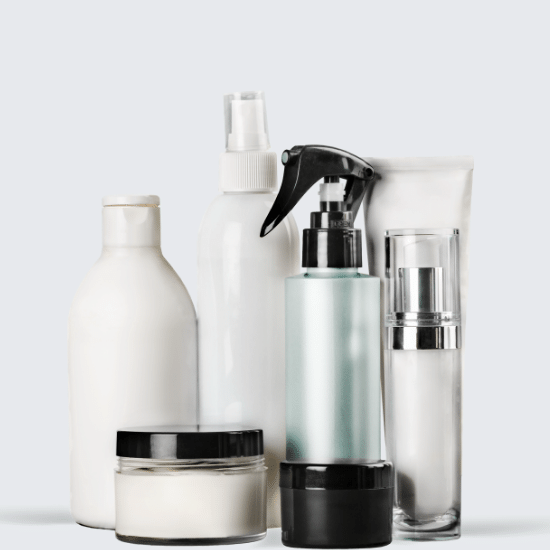
Vegamour is a hair loss company that produces various products targeted toward females with hair loss – specifically, eyebrow hair loss and scalp hair loss. Their full range of products includes various topicals and oral supplements along with brow and lash serums.
For the sake of this review, the focus will be on their most popular products for scalp hair loss: the GRO serums.
Here are the details for the two serums:
Vegamour Product Offerings
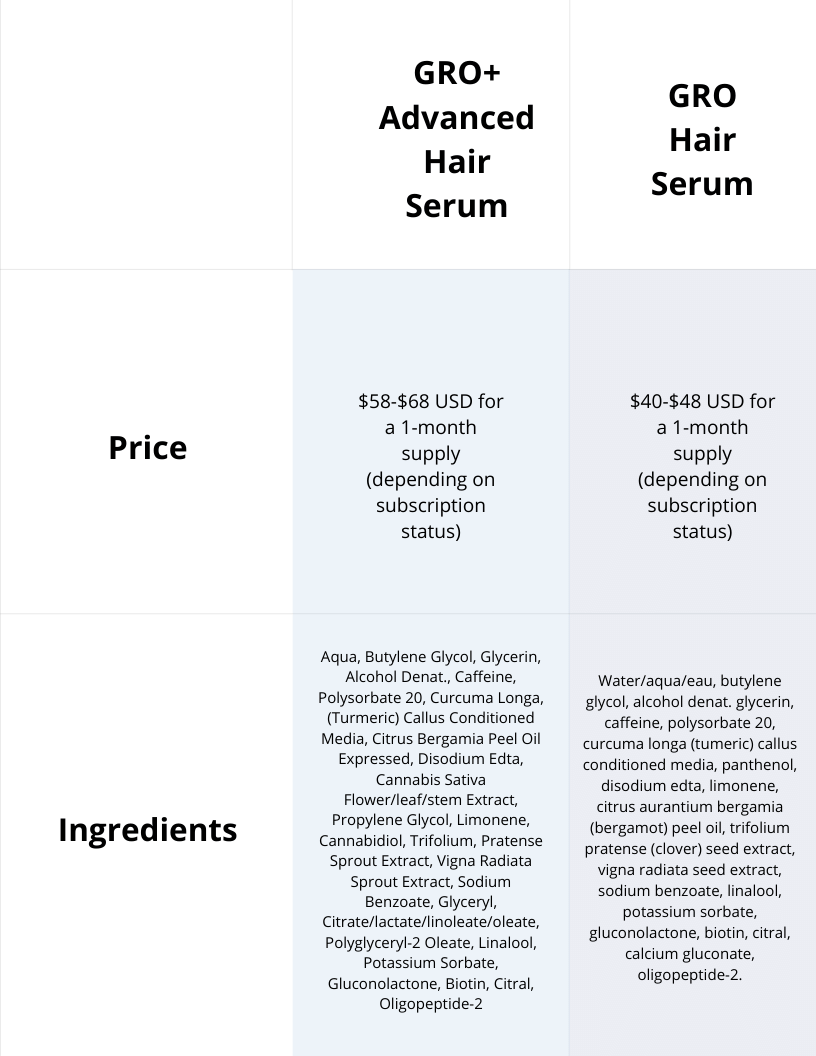
Vegamour Gro Serums: the star ingredients
Vegamour’s Gro serums contain a few star ingredients – ones that we’ll need to investigate to understand if the product is effective for women with hair loss. Why has Vegamour selected these ingredients for hair growth?
To answer this, Vegamour’s claims must be compared with the studies they reference to support their claims.
Vegamour’s GRO Serums
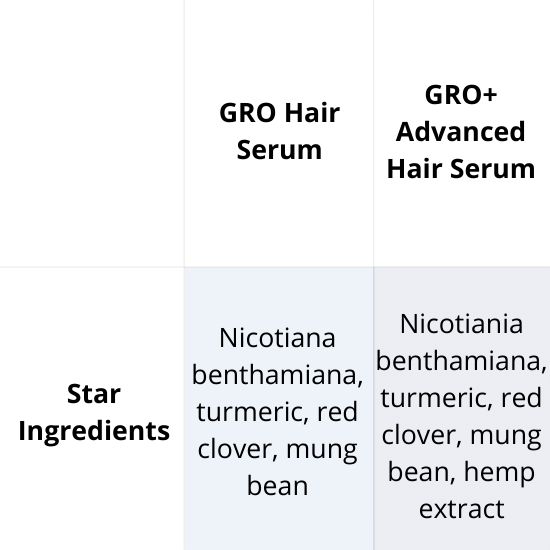
On their sales page, Vegamour claims that:
- The combination of red clover and mung bean helps reduce DHT and inflammation, which fortifies the dermal papillae (a.k.a a group of cells that help sustain hair growth).
- Turmeric increases the delivery of IGF-1 and miRNA-31 to the dermal papillae to lengthen the anagen phase, or the growth phase of the hair cycle.
- Nicotinama benthamiana oligopeptide-2 increases the density of hair by up to 50%.
- Cannabidiol (CBD) and other cannabinoids, found in the GRO+ serum, increases blood circulation and reduces hair loss-causing inflammation when applied topically.
These claims sound great for hair growth – they do everything a hair loss topical should do: reduce DHT, lengthen the anagen phase (and thereby hair growth), and increase hair density. And to support these claims, Vegamour cites seven studies (found here, here, here, here, here, here, and here).
Do Vegamour’s claims stack up to science?
Unfortunately, no.
When taking a closer look, the studies that Vegamour cites don’t always support the claims made by the company. Here are a few examples:
- Vegamour cites this study to support the efficacy of red clover and mung bean extract. However, the extract used in this study actually isn’t red clover and mung bean – it’s a patented complex called Capixyl™ containing red clover and biomimetic peptide. Instead, the description of the extracts used in Vegamour’s serums match that of Akosky® Azuki mung bean and red clover extract. Upon further investigation, the manufacturers do claim that the extract improves hair density in men with AGA, according to a clinical trial. However, this trial hasn’t been published or peer-reviewed (which is important for verifying a study’s validity). All that to say, the studies cited by Vegamour aren’t actually talking about the ingredients included in its formula.
- Vegamour cites this study to support that turmeric extract fortifies the dermal papillae through increased IGF-1 and miRNA-31 activity. The study actually provides no such evidence. In fact, the review actually includes a study demonstrating that turmeric alone isn’t effective for promoting hair growth in men with AGA. Rather, it appears to increase hair growth only when combined with minoxidil.
- No studies that Vegamour provides on the website support any claims that Nicotiana benthamiana oligopeptide-2 improves hair density. In actuality, there seem to be no published studies demonstrating any degree of hair growth with the extract.
- None of the studies cited regarding CBD support the claim that it improves circulation when applied topically. Instead, they suggest that CBD, when administered orally, prevents stress-induced increases in blood flow restriction.
Do the CBD-related claims made by Vegamour match up with the studies?
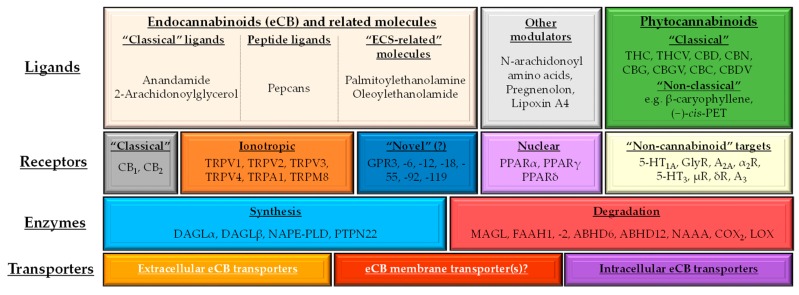
Tóth KF, Ádám D, Bíró T, Oláh A. Cannabinoid Signaling in the Skin: Therapeutic Potential of the “C(ut)annabinoid” System. Molecules. 2019;24(5):918. Published 2019 Mar 6.
Yes. Vegamour claimed that cannabidiol decreases inflammation when applied topically. And while checking their sources, it seems like the study they cite supports this. But there’s one caveat, albeit an ironic one.
The activation of the endocannabinoid system in the hair follicle, which is accomplished by cannabinoids, actually antagonizes hair growth. In fact, activators of this system are actually being investigated to reduce unwanted hair growth.[1]https://www.ncbi.nlm.nih.gov/pmc/articles/PMC6429381/
While cannabinoids do reduce inflammation, they might actually do so at the expense of hair growth. Ironically, this is an ingredient inside their hair growth serum.
So does CBD help improve hair loss in androgenic alopecia or not? A recent case series sought definitive answers.
Researchers took 35 participants (male and female) with AGA and had them apply a topical CBD oil daily. After six months, the results were incredible – at least on paper: a 93.5% average increase in terminal hair counts, and a positive response (i.e., a stop in hair loss or improvement) across all participants [2]https://publications.sciences.ucf.edu/cannabis/index.php/Cannabis/article/view/78/47
With improvements like that – particularly with (1) some participants seeing 350% increases, and (2) the time span of the study being six months – it’s surprising there are no before-after photos featured as part of the study. The new hair surely would’ve had enough time to grow out and demonstrate cosmetic improvements.
Given the growing body of evidence suggesting inflammation’s pathogenic role in AGA, and the potential anti-inflammatory benefits of topical CBD, this treatment could work for a good number of people.
Studies and Hair Growth – The Devil Is In the Details
Companies like Nutrafol often cheat these clinical studies by selecting patients with AGA and low-grade acute Telogen Effluvium (TE) for case series like the one mentioned above, thus obfuscating the true effects of the intervention in question due to the natural recovery of TE throughout a six-month window. But these hair count increases are just too dramatic to explain through that sort of marketing sleight-of-hand.
For what it’s worth, the Perfect Hair Health team has communicated with 15-20 people directly over the years who had mentioned experimenting with CBD oil for hair growth, though none of them reported results. However, it’s entirely possible they didn’t follow through long enough, didn’t apply the right dilutions, or failed to use the right product formulations.
Aside from the “highlighted” ingredients, are there any others that might help regrowth?
Yes. Interestingly, one of Vegamour’s best-supported ingredients is also one that is under-emphasized in its marketing: caffeine.
Unlike the ingredients previously mentioned, caffeine has demonstrated efficacy on par with minoxidil in androgenic alopecia (AGA), and has shown promise in helping to improve telogen effluvium (TE) – a type of diffuse shedding commonly seen in women.[3]https://www.ncbi.nlm.nih.gov/pmc/articles/PMC5804833/[4]https://pubmed.ncbi.nlm.nih.gov/30935254/
Moreover, caffeine is high on Vegamour GRO serums’ ingredients lists (much higher than the spotlighted ingredients). So, why isn’t it spotlighted more? Probably because, nowadays, caffeine is included in most natural hair loss topicals / serums… so the inclusion of this ingredient doesn’t necessarily make the product as unique compared to its inclusion of, oligopeptide-2.
How might Vegamour’s GRO serums improve hair growth?
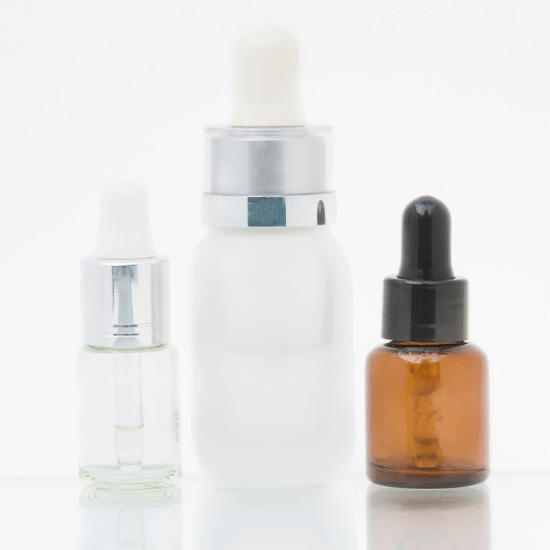
To answer this, one must look at the causes of hair loss in Vegamour’s target demographic (females), and then compare these to the suspected ways in which Vegamour’s ingredients might work to fight these causes.
Specifically, potential Vegamour customers would want to know:
- What signals in the hair follicle cause hair loss in women?
- Are Vegamour’s ingredients likely to override the signals causing the hair loss?
- Is using something like Vegamour’s GRO Serums going to be safer and/or more cost-effective than other treatments for common forms of female hair loss?
The signals that lead to hair loss in women
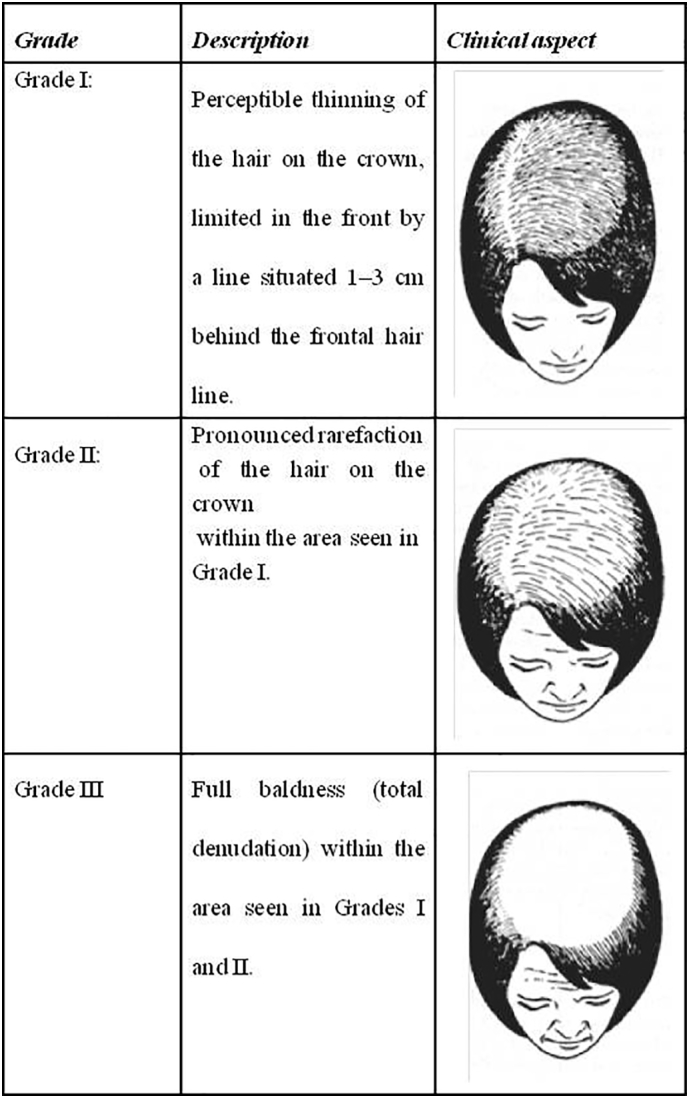
Fabbrocini G, Cantelli M, Masarà A, Annunziata MC, Marasca C, Cacciapuoti S. Female pattern hair loss: A clinical, pathophysiologic, and therapeutic review. Int J Womens Dermatol. 2018;4(4):203-211. Published 2018 Jun 19.
Female pattern hair loss
Female pattern hair loss (FPHL) is essentially female AGA. The condition is characterized by the miniaturization of hair follicles in a diffuse or “Christmas tree” pattern.
However, despite what the name would suggest, FPHL can generally be divided into two categories:
- FPHL alongside hyperandrogenism (high levels of male hormones).
- FPHL in the absence of hyperandrogenism.[5]https://www.ncbi.nlm.nih.gov/pmc/articles/PMC6322157/
In FPHL patients with hyperandrogenism, anti-androgens like ketoconazole shampoo, spironolactone, finasteride, and dutasteride have demonstrated an ability to increase hair density. This suggests that androgens likely play a role in the development of FPHL when hyperandrogenism is confirmed.
Similarly, scalp microflora may also play a role in FPHL, as evidenced by inflammation in the infundibulum of the hair follicle. This provides an additional explanation for the efficacy of ketoconazole, which is also an antimicrobial.
But, FPHL can also occur in the absence of high androgen levels… and the exact mechanism behind this form of FPHL is still unclear.
However, vasodilating, pro-angiogenic treatments like minoxidil have demonstrated efficacy in non-androgen mediated FPHL, suggesting these pathways may at least override the signaling that leads to nonandrogenic FPHL.[6]https://www.ncbi.nlm.nih.gov/pmc/articles/PMC6322157/
Vitamin D and iron are also purported to play a role in both hyperandrogenic and normoandrogenic FPHL, with FPHL patients displaying lower ferritin and vitamin D2 levels than controls. In fact, some studies suggest women with hyperandrogenic FPHL may not respond to anti-androgenic therapies unless a ferritin level of more than 40 mcg/L is achieved.[7]https://pubmed.ncbi.nlm.nih.gov/23428658/[8]https://www.ncbi.nlm.nih.gov/pmc/articles/PMC4560543/
Taken together, the evidence is suggestive of multiple factors as contributors to FPHL. Namely, androgenic activity, microbial overgrowth, inflammation, lack of iron and/or vitamin D activity, and/or possibly a decrease in blood flow – factors that likely vary from person to person.
Telogen effluvium
Telogen effluvium (TE) is a shedding disorder that presents in a diffuse and/or a bitemporal recession pattern. Like FPHL, it is multifactorial in origin. In fact, there are over a dozen potential triggers for TE, including (but not limited to):
- Febrile illnesses
- Emotional stress
- Major surgery
- Childbirth
- Crash diets
- Oral retinoids (Accutane)
- Oral contraceptives
- Hypolipidemic drugs
- Anticonvulsants
- Beta blockers
- Heavy metals
- Hypo/hyperthyroidism
- Organ dysfunction
- Hair dye application
- Zinc deficiency
- Iron deficiency anemia
- Malnutrition (caloric/protein deficit)
- Systemic lupus erythematosus
These triggers, either on their own or in combination with one another, induce the premature transition of many anagen “growing” follicles to telogen “resting” follicles, eventually leading to shedding and a decrease in overall hair density.
The exact mechanisms behind the induction of the telogen phase by each of these triggers is unclear, however, some studies have documented scalp inflammation and mast cell activation in biopsies of TE patients. Additionally, loss of angiogenic growth factors has been shown to inhibit hair growth.[9]https://www.ncbi.nlm.nih.gov/pmc/articles/PMC199257/
As such, it appears that both inflammation and loss of angiogenesis may play a role in TE.
And while most treatment options are confined to trigger resolution, other therapies that target both angiogenesis (like minoxidil) and inflammation have resulted in improvement among TE patients.
Are the ingredients in Vegamour’s serums likely to work?
The following table compares the purported mechanisms of action of Vegamour’s ingredients against the factors believed to contribute to common forms of hair loss in women:
Factors Involved in FPHL, Vegamour’s Proposed Mechanisms of Action, and the Likelihood of Benefit
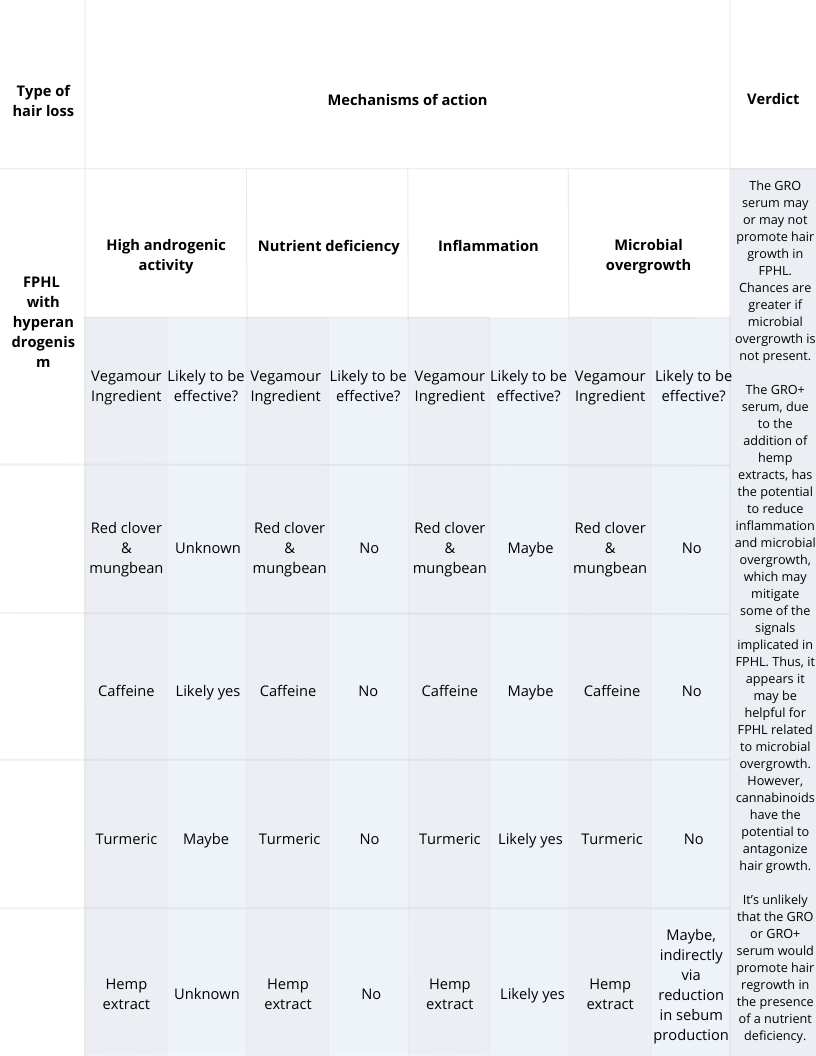
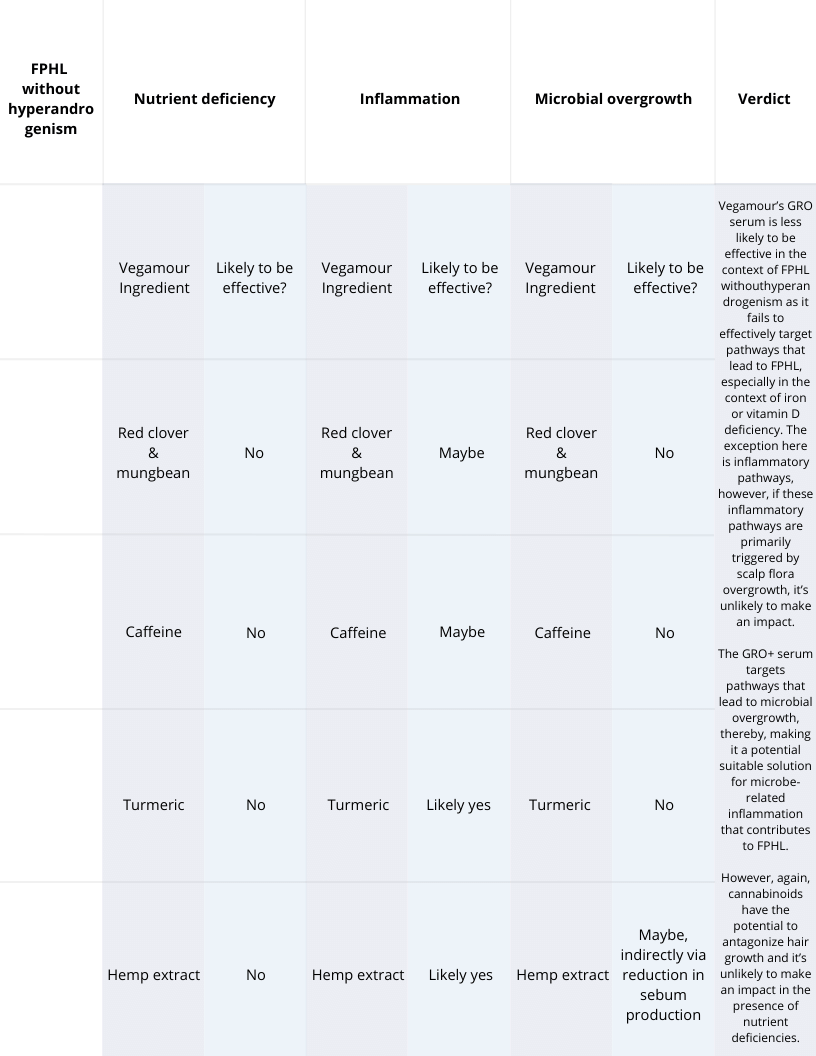
Thus, the evidence is slightly in favor of Vegamour being effective for two types of women:
- Women with FPHL related to increased androgenic activity but not related to iron or vitamin D deficiencies or microbial overgrowth.
- Women with TE-related to scalp inflammation, but not nutrient deficiencies or medication use.
To strengthen (or weaken) this position, we’ll look to the anecdotes.
Do anecdotes suggest Vegamour is effective?
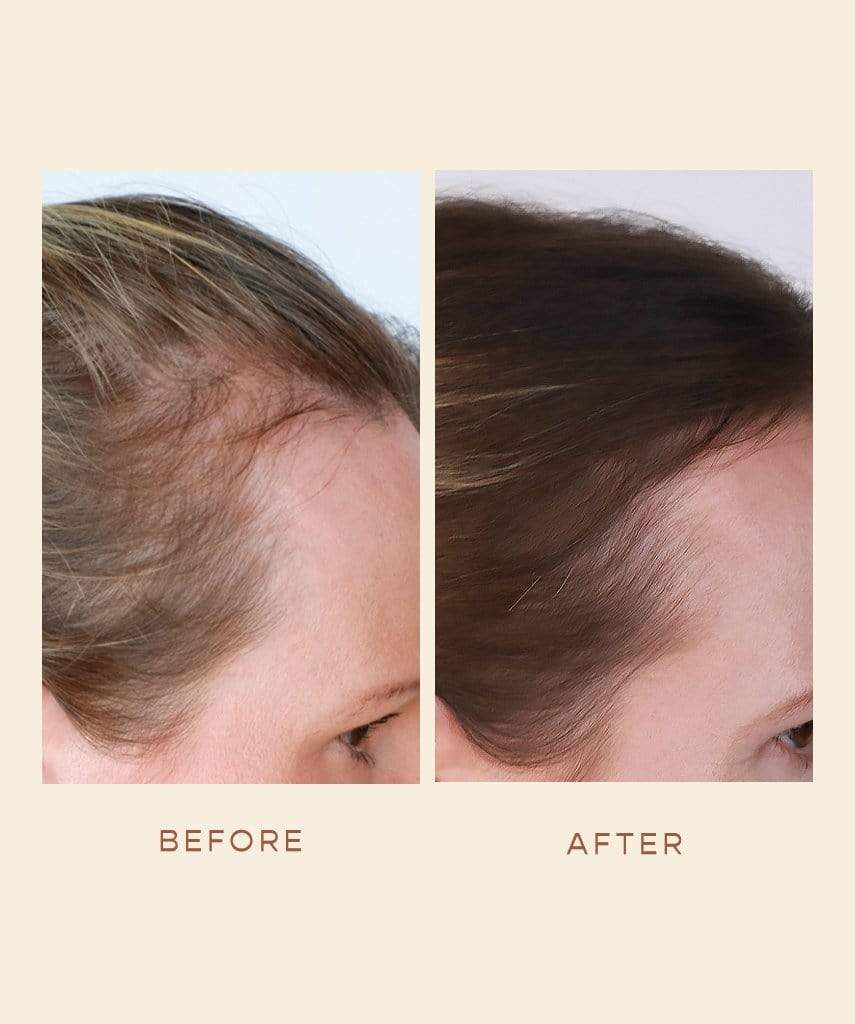
It depends on how one feels about Vegamour®’d before-after photos.
In general, the photosets highlighted aren’t picture-perfect comparisons:
- The photosets feature harsh lighting in the “before” photos and flattering lighting in the “after” photos
- The angles vary, masking huge density increases that outpace the amount of hair growth that is possible between the time windows noted on the photos
- The hair part and combing styles vary to more favorably present the after photos
In other words, they break all of the recommendations we make inside our progress photos guide.
From the anecdotes, it appears that the Vegamour GRO serum might stimulate some degree of regrowth in a portion of women. What is not apparent is the exact form of hair loss these women have… as featuring photosets of women dealing with temporary types of hair loss (like those inside the Nutrafol trial) would skew perceptions of results.
For the volume of product sold, the before-after photos are far and few between. And outside of the photosets featured on that page, positive testimonials tend to claim that the products only reduced their shedding.
Other factors that aren’t covered in these photosets, and that might be influencing results:
- Seasonal gains in density. In the summer, density generally decreases whereas, in the colder months, density generally increases.
- The contribution of other treatments women with hair loss might undertake alongside Vegamour’s serums. For example, medications, supplements, dietary changes, and/or lifestyle modifications.
All this isn’t to say that these serums don’t work; they might for some women. But the photo-grade evidence isn’t as convincing as it should be given the price points.
Comparing Vegamour serums with other treatments
The cost-effectiveness of a product is always going to be tethered to the individual and the causes of their hair loss.
For example, the effectiveness of vitamin D and/or iron repletion is determined by whether or not an individual is deficient. Similarly, the efficacy of treatments like oral minoxidil, spironolactone, and/or finasteride are usually predicated on vitamin D and/or iron sufficiency. In the presence of deficiency, it appears FPHL patients are non-responsive to these treatments.
As such, the cost-effectiveness of treatments is a blanket measurement that won’t be applicable to everyone in the exact same manner. This is to say that some may respond to monotherapies whereas others may need combination therapies targeting multiple aspects of one’s hair loss to see results.
But, even still, hair loss sufferers can get an idea of what might be the most cost-effective approach even with blanket estimates.
Vegamour® vs. other hair loss treatments
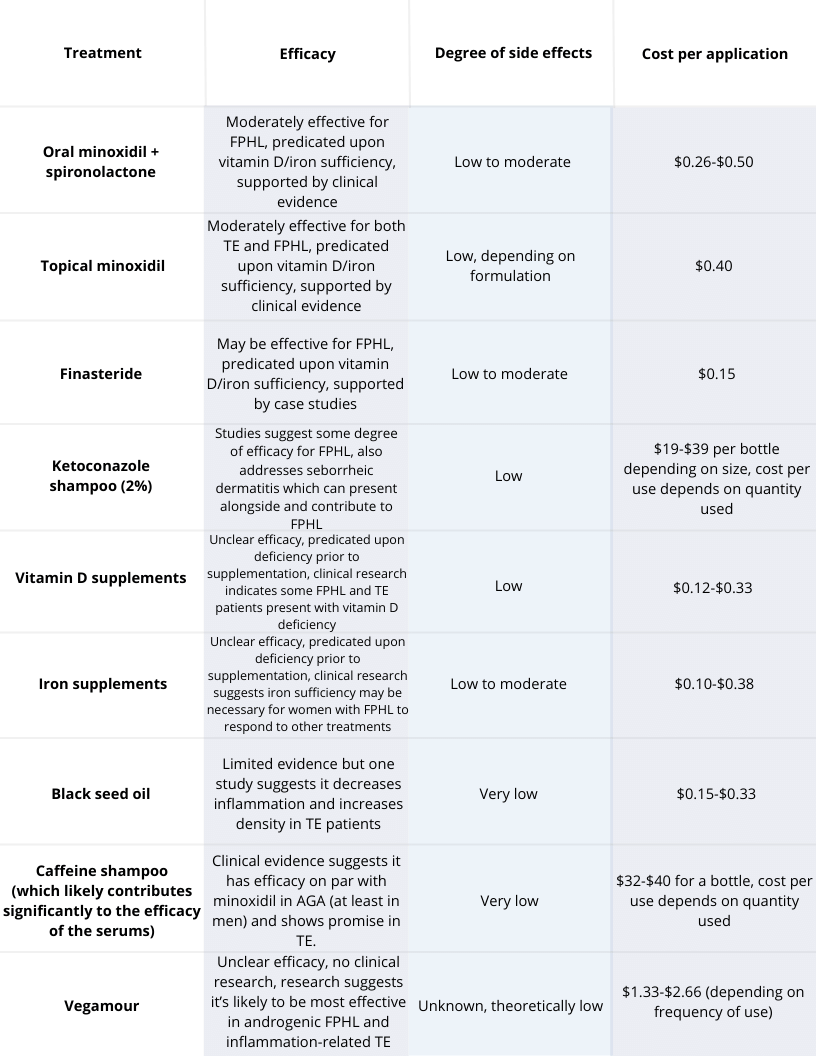
From these comparisons, we can see that Vegamour is clearly much more expensive than treatments supported by significantly more evidence. Moreover, even combination treatments are more cost-effective than Vegamour alone.
As such, Vegamour probably isn’t the best avenue to take when it comes to treating FPHL or TE.
Who might be the best candidate for Vegamour’s serums?
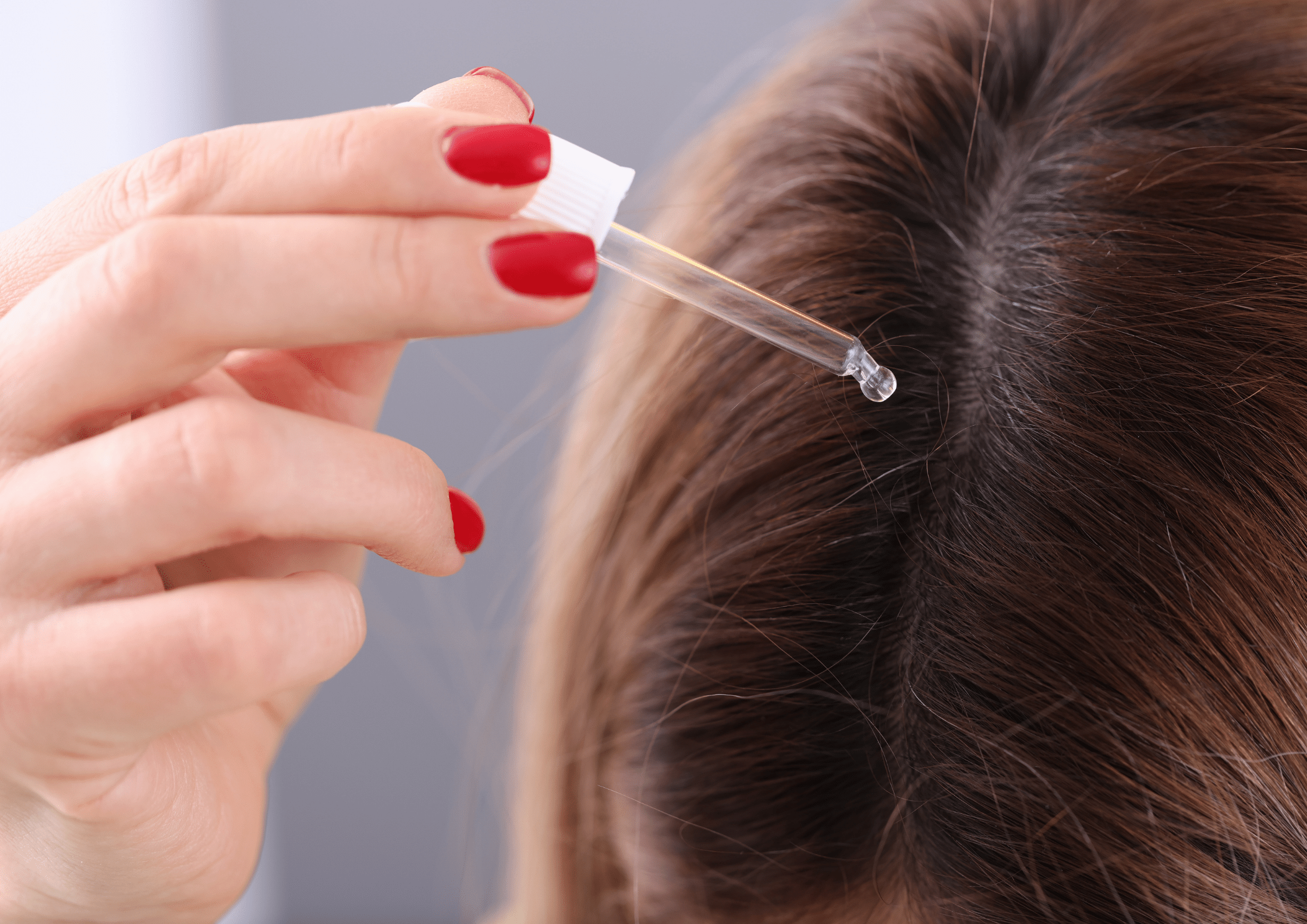
For those who decide Vegamour might still be a viable treatment (and investment), they might be a good candidate for the serums if:
The GRO serum
- TE is related to scalp inflammation.
- FPHL is related to inflammation and androgen activity.
- Treating hair loss 100% naturally is more important than cost-effectiveness.
- Hair loss sufferer is not willing to try other natural therapies with more research to back up their use, like caffeine shampoos or black seed oil.
The GRO+ serum
- TE is related to scalp inflammation.
- FPHL is related to inflammation.
- FPHL is related to microbial overgrowth on the scalp.
- Treating hair loss 100% naturally is more important than cost-effectiveness.
- Hair loss sufferer is not willing to try other natural therapies with more research to back up their use, like caffeine shampoos or black seed oil.
However, these are just estimates on who the products might be most effective for based on the ingredients & their purported mechanisms of action.
In contrast, Vegamour’s serums probably aren’t going to make much of a difference if:
- TE or FPHL are connected to underlying deficiencies.
- TE is related to medication use and the individual is still using the medication.
- TE is related to stress that hasn’t yet been resolved.
Summary
Vegamour’s GRO serums are hot-selling products, but within these products, the studies that the company references to support their ingredients don’t necessarily align with their claims. Some ingredients – like caffeine – do have clinical research to back up their use in common forms of female hair loss like TE and FPHL. At the same time, there’s also clinical research indicating some ingredients – like hemp cannabinoids in the Vegamour GRO+ serum – may antagonize hair growth.
Nonetheless, a combination of theoretical and anecdotal evidence suggests that Vegamour might still work for a narrow group of women: those with androgenic FPHL unrelated to microbial overgrowth or nutrient deficiencies and with inflammation-induced TE but, again, unrelated to underlying chronic conditions.
Considering the totality of the evidence, the company’s misinterpretation of the studies, and the cost of Vegamour’s products, we feel there are products that are much more cost-effective (and that have more research to support their use).
Still, those who do want to invest in Vegamour should assess whether they’re likely to be a good candidate, that which requires an accurate diagnosis beforehand.
References[+]
References ↑1 https://www.ncbi.nlm.nih.gov/pmc/articles/PMC6429381/ ↑2 https://publications.sciences.ucf.edu/cannabis/index.php/Cannabis/article/view/78/47 ↑3 https://www.ncbi.nlm.nih.gov/pmc/articles/PMC5804833/ ↑4 https://pubmed.ncbi.nlm.nih.gov/30935254/ ↑5, ↑6 https://www.ncbi.nlm.nih.gov/pmc/articles/PMC6322157/ ↑7 https://pubmed.ncbi.nlm.nih.gov/23428658/ ↑8 https://www.ncbi.nlm.nih.gov/pmc/articles/PMC4560543/ ↑9 https://www.ncbi.nlm.nih.gov/pmc/articles/PMC199257/ Want help with your hair regrowth journey?
Get personalized support, product recommendations, video calls, and more from our researchers, trichologists, and PhD's dedicated to getting you the best possible outcomes.
Learn More
Perfect Hair Health Team
"... Can’t thank @Rob (PHH) and @sanderson17 enough for allowing me to understand a bit what was going on with me and why all these [things were] happening ... "

 — RDB, 35, New York, U.S.A.
— RDB, 35, New York, U.S.A."... There is a lot improvement that I am seeing and my scalp feel alive nowadays... Thanks everyone. "

 — Aayush, 20’s, Boston, MA
— Aayush, 20’s, Boston, MA"... I can say that my hair volume/thickness is about 30% more than it was when I first started."

 — Douglas, 50’s, Montréal, Canada
— Douglas, 50’s, Montréal, CanadaWant help with your hair regrowth journey?
Get personalized support, product recommendations, video calls, and more from our researchers, trichologists, and PhD's dedicated to getting you the best possible outcomes.
Join Now - Mission Statement